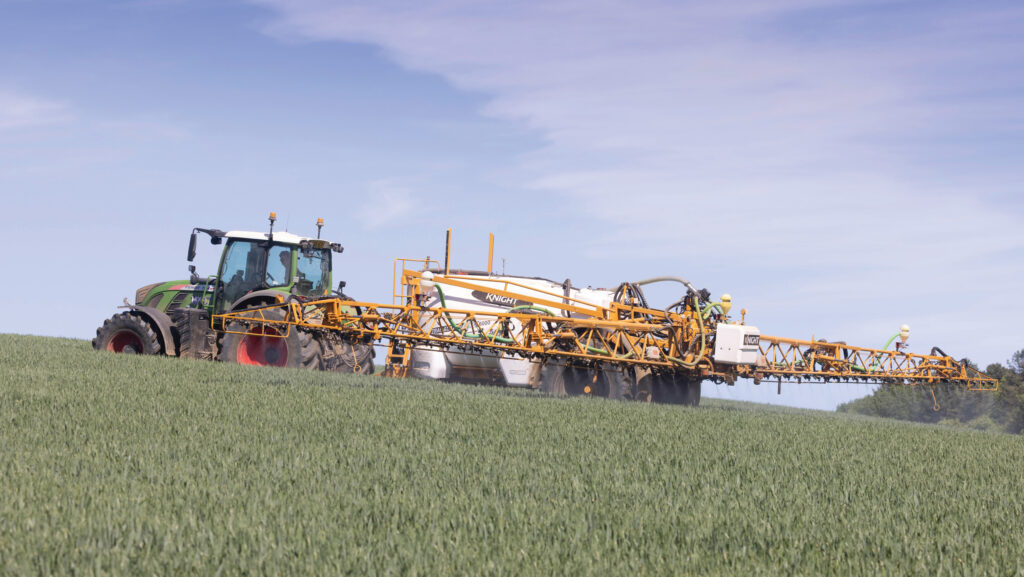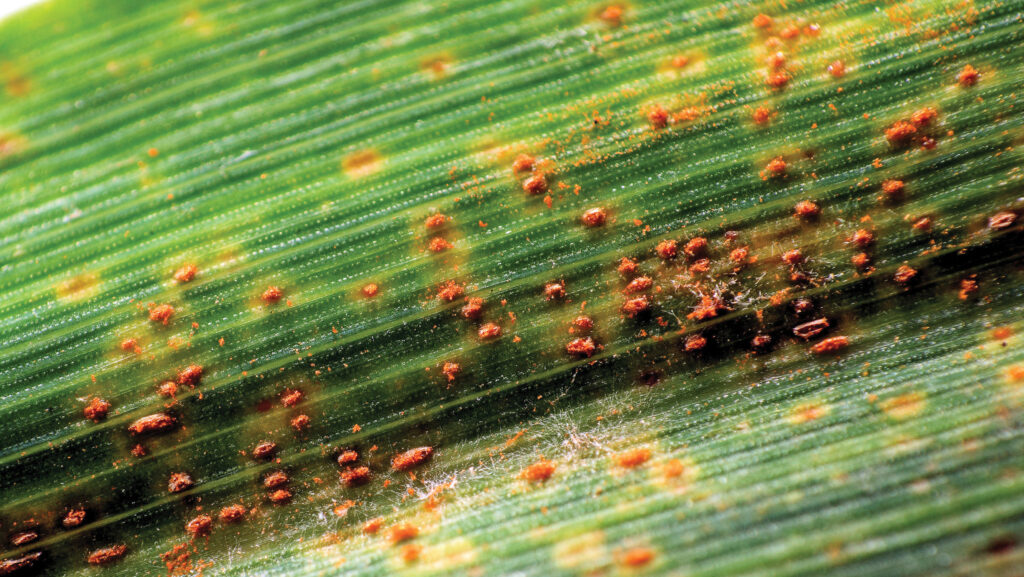Crop Watch: Alarming levels of septoria and short OSR crops
 @ Tim Scrivener
@ Tim Scrivener Conditions are proving perfect for septoria in wheat with the disease at alarming levels, especially in the North.
It’s going to be a battle to keep emerging leaves clean and will test current fungicides in the coming weeks.
Our agronomists are also reporting much shorter oilseed rape crops, in a season that continues to be far from normal.
See also: How farmers will benefit from new SDHI wheat fungicide at T2
North
David Martindale – Arable Alliance (Yorkshire)
If the cropping season was following a script it is hard to imagine what is left to write in terms of making conditions so difficult for growers.
Resilience and determination have been in abundance throughout these hard times, a real credit to all involved.
This was evident again during a small window in the middle of April which saw a crop drilling frenzy of all types. Seed-beds were not always pretty or perfect, however, this seems to be the year where the ideal seems unachievable.
A lot of winter wheat crops have improved. Even the “shall we keep it or write it off?” crops, while they are not going to break any yield records, look more promising now.
Winter wheat T1 fungicides have mostly been applied. The wet April has allowed further spread and development of Septoria tritici which is obvious on leaves four and five. These are now touching the yield forming leaves above to spread the disease further.
On early sown crops with varieties susceptible to Septoria tritici, disease levels are at alarming levels.
While the newest leaves appear clean now it can take two-to-three weeks for lesions to appear. Robust T2 fungicides will be required, although in some cases eradicating Septoria tritici from leaf two could prove challenging.
It is good news that the new SDHI active pydiflumetofen has been approved. It is looking like there will be plenty of disease pressure to test this new active ingredient to the maximum.
Winter barley
Awns are emerging on winter barley crops. T2 fungicides are now being applied to protect the top part of the canopy.
Net blotch and brown rust are still bubbling away in the bottom of the crop, so the T2 fungicide will be required to prevent these diseases spreading any higher.
Unfortunately, crops look stunted where they have suffered prolonged waterlogging, the cold and wet April hardly being conducive for any kind of recovery.
The earliest sown spring barley crops are now tillering and will soon require herbicides to control a wide range of broad-leaved weeds.
Thereafter the crop will compete and limit further weed emergence.
Later sown crops are often on heavier soils and so far establishment has been more variable due to conditions being so difficult to achieve good seed-beds.
Winter oilseed rape crops are all over the place in terms of quantity of biomass and flowering stage.
The straggly crops are flowering at knee height, it seems bizarre to be assessing flowers crouched down. It is ironic that the spring oilseed rape crops could well be taller and have more biomass than many of its winter counterparts this year.
Seed weevil numbers are beginning to increase, so be on the lookout as the secondary damage from pod midge can be significant.
Spring beans have finally emerged having taken what seemed like an eternity to establish. Herbicides are being applied to control grassweeds such as ryegrass and bromes.
West
Neil Potts – Matford Arable (Devon)
Eventually the weather changed and some of the planned spring plantings started to be planted, but it has been a bit stop/go with repeated bouts of rain just to hold things up.
There has also been an unseasonable period of cold which has meant crops are emerging slowly rather than jumping out of the ground.
On the plus side we are not having a rapid dry up and then bake out like we had last year.
I hate to use the phrase “I told you so” but the amount of barley yellow dwarf virus now in evidence is quite shocking.
With many fields not getting any aphicide over the autumn/winter period, despite being planted in the “high risk” window, the price is now being paid with many barley crops turning rather a nasty yellow colour.
The worrying thing about this is that the wheat is probably yet to show any BYDV and will be further down the input road before it becomes really obvious.
Interestingly many crops that should, based on drilling dates, have had multiple applications of aphicide are fairing pretty well with just one application.
Those crops which did receive two applications are pretty much 100% free of this damaging virus.
Septoria pressure
The wet and mild winter and an equally wet early spring have led to some of the worst septoria I have ever seen, with even highly resistant varieties being severely challenged.
We are going to need robust treatments at T2 and a spell of drier weather if we are going to stand any chance of bringing the situation back under some sort of control.
All the talk further east and north of us is of brown and yellow rust.
I have yet to see any yellow rust and brown rust is present in some crops, but only right in the very bottom of the crop. In these situations a T2 application that is rust active and robust on septoria is going to be the order of the day
In addition to spring barley plantings having happened since I last wrote, the region’s fodder beet plantings are well under way and a good start has been made on the maize crop.
By the time I next contribute the winter cereal season will nearly be all over bar the shouting.
I am hopeful that some crops will perform well this year, but unfortunately there are too many out there where damage limitation is going to be best we can hope for. I hope I may be wrong in this thought process but I fear I am not.
South
Iain Richards – Agrii (Oxfordshire)
Improving crop values and premiums means the key this year is to identify crops with good potential and invest in them.
Those who are able to achieve this may do very well despite the challenging weather conditions.
Wheat growth stages are very mixed. The earlier drilled crops on free-draining soil look fantastic.
They have had a T0 and T1 on time, which has kept on top of any disease, and we expect T2s to go on around 10 May. In contrast, later drillings had their T1s at the end of April.
There is talk of some significant Group 1 premiums this year, so we are paying particular attention to milling wheat to ensure it fulfils its yield potential and hits the contract specification.
Our nitrogen plans factor in a late application at early ear emergence, but we are now having conversations about a further foliar application after this.
Milling premiums could mean £500/ha or more is at stake, so we have to do everything we can to get the required protein levels.
So far, yellow rust has been as much of a concern as septoria. T0 seems to have been crucial this season.
Where it was missed, yellow rust has reared its head prior to T1. The damp and cool conditions following a mild winter have favoured it.
However, rising temperatures will mean septoria cycles more quickly and becomes more of a threat than it is already.
Oilseed rape
Oilseed rape continues to look promising, its pods are setting well, and all crops have received a flowering fungicide spray.
Most crops are shorter than usual, but considering the lack of rooting, this may help manage the lodging risk.
Some crops have great potential, and for those, we will consider a second fungicide at the end of flowering.
This will be a mix of azoxystrobin and prothioconazole, targeting light leaf spot and alternaria and encouraging crop greening.
There is still a long way to harvest, and we want to ensure the best crops fulfil their promise.
Apart from a few very wet fields, all the planned spring crops have been drilled.
Growth stages vary from tillering on the early drilled fields, to crops just emerging.
A lot of the latter was drilled into heavy land at the end of April, and the seed-beds were relatively dry because of the high winds.
Unusually for this season, the heavy rainfall that followed was very welcome.
To encourage our spring barley to get going as quickly as possible, all of our crops will receive a plant growth regulator, phosphite and manganese prior to tillering.
We have found this to deliver significant benefits to root development and tiller production.
We used some pre-emergence herbicides on the very worst blackgrass seed-beds, but less has been used overall because of our concerns about crop safety.
Inevitably, we will use more contact graminicides this season.
Some of the earlier plantings will soon receive their broad-leaved weed herbicides alongside their first fungicide.
These crops have impressed since drilling, and our focus on encouraging tillering and root development seems to be paying off.
East
Ben Pledger – Farmacy (Bedfordshire/Hertfordshire)

© Blackthorn Arable
Even though the start of spring has been cold and wet, brown rust is quite evident in winter wheat, especially varieties with lower risk ratings for the disease such as Crusoe and Cranium.
An added dose of tebuconazole in with the T1 fungicide was employed to knock this out, but with the weather potentially warming and drying up, the disease won’t be quick to go away.
This should be taken into account when planning your T2 fungicide, ensuring that protection is extended at this timing.
Do not delay going in with a T1.5 fungicide to protect leaf 2 and clear out any more rust should the problem persist. Keep an eye on tebuconazole products and their labels regarding total doses of product if using the active ingredient multiple times in your fungicide programme.
If also targeting septoria at T2, fenpicoxamid is a useful active ingredient to employ as it is not an SDHI or a strobilurin fungicide, being in a chemical group of its own.
This still allows more flexibility regarding applications of SDHI and strobilurin fungicides depending on what you have applied previously.
Remember you are only allowed two foliar applications of SDHI fungicides, and two applications of a strobilurin fungicide per fungicide programme.
Slug pressure
With the wet weather we have had over the past six months slugs have been a big problem with regard to establishing spring crops, especially spring cereals.
The slugs I’m finding are very small, only 5mm long in places and hard to spot, but there are plenty there once you’ve got your eye in.
Slug traps have been placed out and are being monitored regularly.
Where slug activity is evident, ferric phosphate pellets have been applied, and in some cases, re-applied after a few days where problems persist and the first dressing had been eaten.

